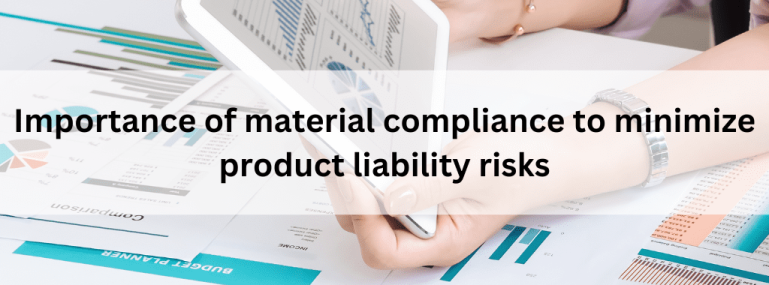Material compliance is a critical component of product liability risk management for manufacturers, distributors, and suppliers in today’s complex regulatory environment. The use of non-compliant materials in products can result in defects, malfunctions, safety hazards, and even legal consequences, leading to serious financial and reputational risks.
Understanding material compliance is essential for reducing product liability risks. By ensuring that all materials used in the production of goods meet regulatory standards, businesses can protect themselves from potential lawsuits, injuries, and damages. In this blog, we will discuss the importance of material compliance in relation to product liability and provide effective solutions to mitigate these risks.
What is Material Compliance?
Material compliance refers to a product or its components adhering to applicable rules, regulations, standards, and specifications regulating their composition, manufacturing, and use. These requirements may differ depending on the industry, area, and type of product. Material compliance regulations include restrictions on hazardous substances, such as the Restriction of Hazardous Substances (RoHS) directive for electronics, regulations on chemical substances, such as the Registration, Evaluation, Authorisation, and Restriction of Chemicals (REACH) regulation in the European Union, and product safety standards, such as the International Organisation for Standardisation (ISO) standards.
Impact of Material Compliance on Product Liability
If a product or its components fail to meet relevant norms or standards, it may endanger consumers or other stakeholders, potentially leading to product responsibility claims. Product liability can have serious repercussions, such as financial losses, legal fees, brand reputation damage, and even company disruption.
Best Practices in minimizing Product Liability Risks and being compliant with Material compliance regulations:
To mitigate product liability risks related to material compliance, it is crucial to implement best practices throughout the product lifecycle. Some practical ways to reduce product liability risks and ensure material compliance are outlined below:
- Compliance with applicable laws and regulations: Keep up to date on material compliance laws, regulations, and standards in your industry and geography. Establish methods to ensure that your products and components, including material composition, manufacturing processes, and usage, meet these requirements.
- Quality control and testing: Implement robust quality control processes in your manufacturing operations to verify that materials and components meet the required standards and specifications. Conduct regular testing for material composition, performance, durability, and safety to identify and address any non-compliant materials early in the production process.
- Supplier management: To ensure that your suppliers offer compatible materials and components, thoroughly vet and monitor them. Conduct supplier due diligence, verify their compliance certifications, and establish clear material compliance expectations in supplier contracts. Suppliers should be monitored and audited on a regular basis to guarantee continuous compliance.
- Documentation and record-keeping: Maintain comprehensive documentation and record-keeping of material compliance to demonstrate compliance with regulations and standards. This includes material specifications, test reports, certificates of compliance, and other relevant documentation that can be used as evidence in case of product liability claims.
- Risk assessment and mitigation: Conduct thorough risk assessments to identify potential material compliance risks and implement appropriate mitigation measures. Assess the potential impact of non-compliant materials on product performance, safety, and regulatory compliance, and take corrective actions to address any identified risks.
- Insurance coverage: Obtain appropriate product liability insurance coverage to provide an additional layer of protection in case of material compliance-related claims. Consult with an insurance professional to determine the appropriate coverage for your business, including potential damages and legal expenses associated with product liability claims arising from material non-compliance.
Conclusion:
Material compliance is a critical consideration that can substantially impact product liability concerns. ComplianceXL helps organizations to develop and implement compliance management programs to adhere to applicable regulations, develop robust quality control methods, manage suppliers professionally, maintain complete documentation, and conduct a risk assessment to ensure that the product’s quality is maintained. Talk to one of our Material Compliance specialist today to learn more!
FAQs:
1. What are the dangers of product liability?
Faulty or unsafe items can cause harm or injury to consumers, as well as costly lawsuits and reputational damage.
2. What are the three primary categories of product liability?
Product liability is classified into three categories: manufacturing faults, design defects, and failure to warn.
3. What is the definition of liability risk reduction?
The danger of being held liable or responsible for an action or omission, whether at fault, resulting in a direct or indirect financial loss is a sort of operational risk.





